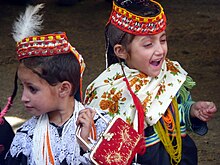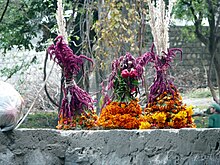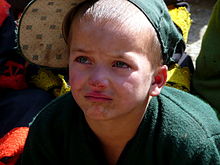Kalasha (Chitral)
The Kalash of Chitral , or simply Kalasha , are an ethnic group living in the Hindu Kush region of Pakistan , in the Rumbur, Bamburate / Bumburet and Birir valleys . They are also called Kasivo by their neighboring peoples, the Nuristani . The Chitral-Kalasha are a Dardian people , the name of their language is Kalasha-mun . Their appearance is considered unique, especially for the region in Central Asia . A strikingly large number of Chitral Kalashes have light skin, light hair and light eyes.
The appearance and the polytheistic religion of the Kalash led to numerous hypotheses of ancestry from south-eastern Europe , which, however, could never be proven.
Remarkably, there is no direct connection to the Kalash of Nuristan (formerly Kafiristan- Kalasha). Both ethnic groups come from different branches of the Indo-Iranians , a division that was probably made several thousand years ago. According to the linguist Richard Strand , the Chitral Kalashes took their name from the Kafiristan Kalashes, who expanded their influence to Chitral at an unknown time. Proof of this assumption could be the Kalasha terms kâsv'o and kâsi'o , which are still used today and are used by the Nuristani peoples, Kata and Kom . From these the name Kasivo (instead of Kalasha) can be derived.
There is disagreement in Pakistan on how to define the Kalashas as an ethnic group. In the 2018 census, 3800 Kalashes were counted. Around 1950 this people still had around 30,000 members.
Culture
The exact relationship to the former Kafiristan-Kafiri (today's Nuristani) is still unclear due to a lack of references and sources. Basically, however, a different close and intense mutual influence is assumed in the course of history.
Although there are significant Kafiristan-Kafiri influences in the language and religion, the culture and religion of the Chitral-Kalasha today is drastically different from any other of its neighboring peoples. The religion that developed from that of the Kafiristan-Kafiri could be counted among the few similarities. With the Islamization of the Kafiristan-Kafiri in 1895, however, this commonality also ended.
In order to document and preserve the Kalash culture, a written language based on the Latin alphabet has recently been developed.
Chitral Kalasha women usually wear long black robes, often embroidered with porcelain snails. For this reason the Kalashes are also referred to as "the black kafiri " by their neighboring peoples in Chitral . The men have adopted the traditional Pakistani garment Salwar Kamiz , children mostly wear small versions of these clothes from the age of 4.
Her society is currently in a state of upheaval. While abundance or wealth in livestock and grain used to be measured, more and more independent farmers are switching to a cash-supported economy.
Kalash religion
The Chitral-Kalasha believe in several deities, called Mahadeo in Kalasha-mun . In addition, Khodai - in Khowar the word for God - is also used. This term has long assumed monotheistic traits. Furthermore, the various aspects of life are assigned a corresponding deity. For example, Jeshtak stands for family, pregnant mothers and marriage.
The anthropologist Alberto Cacopardo, who has researched the Kalasha for several decades, suspects the roots of its belief in an ancient Indo-European religion that goes back a long way.
As part of their religious tradition, the Kalashians know animal (especially goat), milk and wine offerings; The natural resources of its three valleys are remembered in lavish celebrations. Purity and impurity is a highly complex component of the Kalash religion, accompanied by numerous taboos and ceremonies. This applies to the Chaumos purification festival , which is celebrated with a fire ritual on the winter solstice , and to initiation celebrations . The huge ancestral figures are striking: The ancestor worship is pronounced, and it is believed that the ancestors live in the figures as long as their descendants think of them. You take part in the festivities invisibly.
In addition to the creator god Imra and Indr or Varendr , of whom certain properties have been compared with those of the Vedic Indra , as well as gods of nature, the Kalasha know fertility and shepherd gods, demigods, spirits and demons who live in rocks and trees. In terms of personnel, the religious center is the Dehar , who is reminiscent of the shamans of Siberia. The Kalasha, Nuristani and other Dardic peoples have certain traditional ethno-cultural characteristics in common, which are classified with the term “Himalaya-Pamir-Hindu Kush” and differentiated from a “Vedic” layer.
Every year towards the end of May the Joshi (Spring) Festival, one of the most important celebrations, takes place. Since the Kalash is not aware of any kind of calendar, the beginning of this festival is determined with the help of the position of the sun. The first day of this festival is called "Milk Day". Milk offerings that have been collected up to 10 days before the start of the festival will be served. Other important religious festivals are: Ratnat , Po'n ' ( Phool ), Chawmos and Madaik and Uchaw . The festival Suri Jagek was in the 2017 list of urgent conservation need of the Intangible Cultural Heritage of UNESCO added.
In contrast to the strongly Islamic culture that surrounds them, the Chitral Kalashes do not know a general separation of men and women. Only during the cycle does a woman leave her home and live in the village women's refuge until her period is suspended and her “purity” is regained. In this building, known as Bashali , the children are also born. After a birth, a special rite is performed again to restore “purity”, in which the husband plays an important role. Kalash women breastfeed their children in public. Although in the Kalashian marriages the families arrange marriages, mature women and men can make their own decisions. This, and the fact that Kalasha women deal with men completely freely in public, has repeatedly led to violent protests in strictly Muslim circles.
The conversion to Islam offered a way out to avoid the rigid restrictions on the choice of partner by the prohibition of marriages which have a male ancestor for seven (today three) generations.
history
At the beginning of the 18th century, the Chitral Kalash were defeated by the Mehtar of Chitral . However, this did not result, as is usual, in increased assimilation or forced Islamization. On the contrary, the Chitral-Kalasha succeeded in establishing good and friendly relations, especially with the largest ethnic group in Chitral, the Kho (Khowar).
The multiethnic state of Chitral was able to ensure in recent times that the Kalashas were able to live largely independently and to practice their religion largely freely. That this is by no means the norm is shown by the fate of the Nuristani of Afghanistan , historically connected neighbors of the Chitral-Kalasha. These were defeated by Abdur Rahman Khan at the end of the 19th century and their culture was completely and absolutely forced to Islam .
Before this annexation, Kafiristan (today's Nuristan) belonged largely to the area of influence of the Mehtar of Chitral, the Kafiris were tributary to him and accepted his sovereignty. The Durand Treaty, however, consolidated this secession, and Kafiristan finally became part of Afghanistan.
The pressure from supporters of radical political Islam is increasing. One example is the Islamist Tablighi Jamaat movement, which is close to the Taliban and is responsible for numerous attacks on the Kalasha. According to local residents, forced conversions are the absolute exception.
Since 2018, the Kalashas have been represented for the first time by one MP in the parliament of the Khyber Pakhtunkhwa province .
Agriculture and Climate
The home region of the Kalasha is in the province of Khyber Pakhtunkhwa in the three valleys of Rumbur, Bumburet and Birir. This region is considered extremely fertile, the mountain slopes are dominated by mighty oak forests. Although most of the work is not done with machines, but by conventional manual labor, the Kalashians practice intensive agriculture. The wild and dangerous rivers that flow through the Kalasha valleys drive mills and are also used for irrigation in agriculture by means of ingenious canal systems. In addition to wheat , corn and (for wine production) grapes , apples and walnuts are also among the foods that grow in the region. Excess or residual food is used to feed the cattle.
The Kalashes are fighting a lawsuit with the Chitral royal family over parts of an area . In 2018, the Pakistani Supreme Court ruled that two-thirds of the land of five villages belong to the former Mehtar's family, while one-third belong to the residents. But the Mehtar's family refuses to implement the judgment and release the land. In order to get better chances in court, 40 of the 100 families affected converted to Islam. The legal dispute also concerns the management of forests.
The climate corresponds to that of a typical high mountain region, without large amounts of water that could affect the temperature. The summers are mild and pleasant with average maximum temperatures between 23 and 27 ° C. In contrast, winters can also be cold, with average minimum temperatures of 2 to 1 ° C. The mean annual rainfall is between 700 and 800 mm.
Genetic disposition
Recent genetic studies have shown that the Kalashes are a largely isolated population group that moved away from a common Eurasian origin at a very early stage. The Kalashes share certain genes with populations of Siberian hunters and gatherers from the Stone Age. There is no evidence of a genetic influence from Southeast Europe. mtDNA studies have shown that there is also no East Asian genetic influence. This makes the Kalash in stark contrast to some of their closest Indo-European neighbors.
tourism
Tourism already forms a large part of the economic life of the Chitral-Kalasha, which have suffered economically from its decline since 2001. There is a simple infrastructure with local passenger transport, accommodation and small shops.
The (free) escort in the form of an armed police officer, which is mandatory for foreign tourists for their protection throughout the province of Chitral, has not been required since the beginning of 2019.
Religious celebrations are extremely serious for the Kalashians, spontaneous "feasting" or dull "gawking" is considered very inappropriate. Openly preaching or practicing any foreign religion is therefore interpreted as disrespect for the Kalasha. Many tourists lack sensitivity to the Kalash culture, which is often seen as a museum “showpiece”. However, this mainly affects national, Pakistani tourists, who are often only attracted by the alcohol consumption tolerated in Kalasha, as there is a strict alcohol ban in the rest of Muslim Pakistan. International tourists are generally welcomed warmly if there is an opportunity despite escort.
The National Human Rights Commission of Pakistan recommends state institutions to disseminate more information about the nuances, do's and don'ts of the Kalashic culture.
Literature (in German)
- Adolf Friedrich : Diary of the German Hindu Kush Expedition. (Ms., South Asia Institute, Heidelberg 1955/56)
- Albert Herrlich, Arnold Scheibe, Wolfgang Lentz: Germans in the Hindu Kush. Report of the German Hindu Kush Expedition 1935 of the German Research Foundation. Berlin 1937
- Karl Jettmar : The hill tribes of West Pakistan. Development and Political Destinies. In: Bustan, 3, Vienna 1961, pp. 35–44. "Winemaking and wine rituals in the Hindu Kush" in: Festschrift for Helmut Petri, ed. by Kurt Tauchmann, pp. 191-205. (Cologne, Vienna 1973) The religions of the Hindu Kush (Stuttgart 1975)
- Peter Snoy (with Friedrich Kußmaul and Gertrud Kuhn): Hill tribes in the Hindu Kush (Inst. For Foreign Relations and Linden Museum, Stuttgart 1972)
- Uwe Topper : Observations on the culture of the Kalasch (Hindu Kush). In: Journal for Ethnology, Vol. 102, Issue 2, Braunschweig 1977, ISSN 0044-2666 , pp. 216-296
Literature (in English)
- Kendall D. Decker: Languages of Chitral . 1992, ISBN 969-8023-15-1 ( http://www.ethnologue.com/show_work.asp?id=32906 ).
- Georg Morgenstierne : Report on a Linguistic Mission to Afghanistan . Instituttet for Sammenlignende Kulturforskning, Series C I-2, Oslo 1926.
- Khowar English Dictionary (by Mohammad Ismail Sloan, 1981) ISBN 0-923891-15-3 (published in Pakistan, reprinted in 2006).
- Debra Denker: Pakistan's Kalash People . In: National Geographic Magazine , Oct. 1981, pp. 458-473.
- Sir George Scott Robertson : The Kafirs of The Hindu-Kush . Lawrence & Bullen Ltd., London 1896.
Web links
- Website about the history of the Kalasha ABC book and the Kalasha conversation book (English)
- Report about the Kalash in "The South-Asian" (English)
- Report about the Kalasha on "everyculture.com"
Individual evidence
- ↑ a b c d e f g The last of the Kalasha , Shah Meer Baloch, Dawn , March 12, 2019
- ↑ a b c d Volker Pabst: The unconverted from the Hindu Kush . Neue Zürcher Zeitung, November 22, 2016
- ↑ a b c d e f Saga of Survival. A Report on the Protection, Preservation and Promotion of Constitutional Rights of Indigenous Kalash People. National Commission for Human Rights, Pakistan, 2018, pp. 5, 6, 11f., 15 f., 19 f.
- ↑ a b Nicolas Autheman: Wazir the Greek . Le Monde diplomatique, May 14, 2010
- ↑ Nuristân , Website Richard beach
- ↑ Tan mon kitap maik // Kalasha reading in their own language , Kalasha ABC and conversation book, accessed April 1, 2019
- ↑ Uwe Topper: Observations on the culture of the Kalasch (Hindu Kush). In: Zeitschrift für Ethnologie , Vol. 102, Issue 2, Braunschweig 1977, ISSN 0044-2666 , pp. 216-296, especially Part V: Religion
- ↑ Mihály Hoppál : The Book of Shamans. Europe and Asia. Econ Ullstein List, Munich 2002, ISBN 3-550-07557-X . P. 421 f.
- ↑ Hendrik Neubauer (Ed.): The Survivors - From the native to the world citizen. Tandem, Potsdam 2008, ISBN 978-3-8331-4627-5 , pp. 94-96.
- ↑ Michael Witzel : Kalash Religion. Excerpt from: The Ṛgvedic Religious System and its Central Asian and Hindukush Antecedents. In: A. Griffiths, JEM Houben (Ed.): The Vedas: Texts, Language and Ritual. Forsten, Groningen 2004, pp. 581–636
- ↑ Abbas Zaidi: Ethnic Cleansing of the Kafirs in Pakistan.
- ↑ Peter Parkes: "Enclaved knowledge: Indigent and indignant representations of environmental management and development among the Kalasha of Pakistan" ( Memento of September 28, 2007 in the Internet Archive ) (English)
- ↑ khyberwatch.com: Kalash Valley - Climate (English)
- ↑ Q. Ayub, M. Mezzavilla, L. Pagani, M. Haber, A. Mohyuddin, S. Khaliq, SQ Mehdi, C. Tyler-Smith: The Kalash genetic isolate: ancient divergence, drift, and selection. In: American Journal of Human Genetics . Volume 96, number 5, May 2015, pp. 775-783, doi : 10.1016 / j.ajhg.2015.03.012 , PMID 25937445 , PMC 4570283 (free full text).
- ↑ Qasim Ayub et al .: "Investigation of the Greek ancestry of northern Pakistani ethnic groups using Y chromosomal DNA variation" ( Memento from November 5, 2015 in the Internet Archive ) (English)
- ↑ Lluís Quintana-Murci et al., "Where West Meets East: The Complex mtDNA Landscape of the Southwest and Central Asian Corridor", American Journal of Human Genetics 74 (5), May 2004, pp. 827-845, PMC 1181978 ( free full text) (English).
- ↑ The Kalasha Times, April 16, 2019
- ↑ Chitral Association for Mountain Area Tourism: Code of ethics for visitors to the Kalash valleys (English)
- ↑ Jürgen W. Frembgen : The longing for earthly paradise: Ethnotourism to the Kalasha , International Asia Forum , Vol. 24 (1993), No. 1-2, pp. 45-56











